Industry Guide to Improving Your Supply Chain
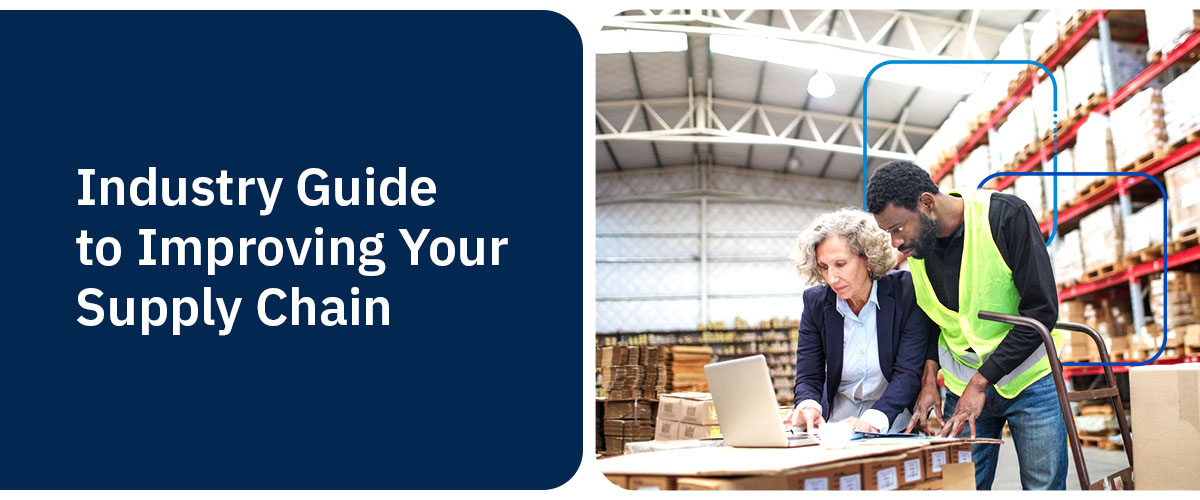
Effective supply chain management is integral for company success. Managers must track the entire flow of products, from raw material shipments to consumer deliveries. The right management techniques maintain customer satisfaction, keep revenue streams healthy, and reduce delays.
Supply chain improvements refine management approaches, keeping your organization competitive and efficient. Enhancement strategies vary by industry because each field faces unique challenges and risks. By evaluating your risks, you can adopt approaches that keep operations as smooth as possible.
Benefits of Supply Chain Improvements
Supply chain management is an ongoing process, helping you prepare the most effectively for current demands and trends. You can keep your supply chain in an ideal condition with continual improvement.
Here are some of the main benefits of supply chain improvements:
- Reduces costs: Supply chains must meet customer demands while maintaining the lowest operating costs. Efficient supply chains have decreased expenses for supplies and storage. By keeping accurate inventory counts, you don’t have additional charges for unused warehouse space. Proper management techniques also help you forecast stock-outs and avoid material shortages that cause downtime. You can meet crucial production deadlines and maintain healthy revenue cycles.
- Improves customer satisfaction: Improved supply chain techniques also boost customer satisfaction rates. Consumers expect high-quality products and speedy delivery times. By meeting these needs, you remain competitive in your industry. You can forecast customer demands and keep optimal numbers in your inventory to improve customer satisfaction. Enhanced customer service approaches also improve their experiences.
- Enhances supplier collaboration: Supply chains rely on large networks of suppliers to fulfill orders. The more efficient and stable your company is, the better support you can provide for your partners. Interconnected and communicative supply chains have more transparency and reduce risks from miscommunication.
- Increases resilience: Supply chain risks are inevitable, but effective management techniques reduce negative effects. Building response plans for specific threats keeps you more prepared. You can remain resilient and agile when confronting internal and external risks.
How to Mitigate Supply Chain Risk
Addressing supply chain risks boosts your resilience. While you can’t avoid risks entirely, you can reduce their impacts. For instance, take the following steps:
- Conduct risk assessments: Risk assessments analyze your position in the supply chain and which threats affect you the most. Draft an end-to-end view of your supply chain and identify potential bottlenecks and vulnerabilities. Risks can be within your control, such as employee efficiency, or out of your control, such as weather conditions.
- Prioritize potential risks: After determining the most pressing risks to your supply chain, prioritize them by frequency and severity. You can address frequent and high-impact risks first to minimize their effects.
- Build response plans: Develop strategies for supply chain risks to keep your organization functioning properly. For instance, a supplier could live in a region that endures many hurricanes, which limits efficiency. You could increase inventory orders from this supplier before hurricane season to ensure you don’t experience stock-outs.
What You’ll Learn in This Guide
This guide explains how to improve your supply chain for various industries. You’ll learn the specific risks affecting each industry and the best approaches for mitigation.
TrueCommerce is a globally recognized provider of supply chain solutions. Our Electronic Data Interchange (EDI) and Vendor Managed Inventory (VMI) solutions can improve your supply chain operations, whatever your industry. To learn more, contact us today.
Find Your Industry:
- Grocery Industry
- Hardware Industry
- Electronics Industry
- Furniture Industry
- Automotive Industry
- Manufacturing Industry
- Health & Beauty Industry
- Healthcare Industry
- Consumer Goods Industry
- Pet Supply Industry

Improving Your Supply Chain in the Grocery Industry
The grocery store supply chain is responsible for providing fresh and sufficient supplies of food products to consumers. As grocery stores face modern obstacles, such as the rise of eCommerce, supply chain managers must adapt their approaches to remain efficient.
Learn more about common challenges for grocery supply chains and the best ways to enhance management techniques.
Grocery Supply Chain Challenges
Supply chain challenges prevent grocery stores from keeping shelves stocked and customers satisfied. To remain competitive in the food industry, you should provide a wide selection of products and top-quality customer service. However, various obstacles make these goals less achievable. Learning more about grocery risks helps you prepare for their consequences.
Here are a few significant grocery store supply chain issues:
- Growth of eCommerce: Consumers worldwide continue to prefer online shopping, and grocery stores are no exception. Online options for food and beverages are increasing, giving consumers many choices for food purchases. By choosing these options, customers avoid grocery store crowds and save considerable time. However, eCommerce can decrease in-store visitation and impact grocery store revenue cycles. Inventories also feel the strain of meeting customer demands while following strict traceability standards and shelf lives.
- Differences in technology: Grocery stores work with many suppliers to keep sufficient inventory levels. For instance, prepackaged goods often come from different suppliers than fresh produce. Each supplier could use different technological systems for communication and shipment tracking. The technology disparity makes it challenging to communicate with everyone effectively.
- Lack of visibility: Visibility is crucial for food supply chains. Traceability proves where a food product comes from and whether it meets health and safety regulations. If contamination occurs, proper visibility techniques let officials track all affected products. Managers can experience a lack of visibility if suppliers don’t communicate frequently. Without accurate updates, it becomes difficult to anticipate upcoming shipments and meet customer demands.
- Rising supply costs: Economic uncertainty can harm grocery store supply chains in several ways. Turbulent economies can descend into recessions, which reduce profits by a significant margin. High inflation rates prevent consumers from purchasing the same quantities. As supply costs increase, grocery stores can have more difficulties maintaining stock levels.

How to Improve Your Grocery Supply Chain
Supply chain managers can use various approaches to reduce the impacts of grocery store obstacles. Effective management anticipates these challenges and prepares strategies for response. Here are a few grocery supply chain improvement techniques:
- Upgrade your technology: Your supply chain technology has a direct role in efficiency, communication, visibility, and other important aspects. Outdated or legacy systems could be unable to support modern demands. As eCommerce increases and visibility remains a concern, advanced technology helps you stay competitive. Solutions such as Vendor Managed Inventory (VMI) improve visibility across your supply chain, helping you optimize ordering techniques and inventory availability. You can closely track food products moving through the supply chain, ensuring they meet safety regulations.
- Improve supplier communication techniques: Proper communication between grocery store managers and suppliers is essential. Increasing communication can improve visibility and make up for disparate technology. The sooner you update managers about delays or obstacles, the sooner they can prepare for the challenges. Various software solutions let you communicate instantly with suppliers and other supply chain officials. For example, live chat features allow you to give quick updates or add requests to orders. Tracking software lets managers monitor shipments without asking for manual updates.
- Focus on inventory management: Keeping appropriate stock levels satisfies customers and keeps revenue streams healthy. Improving inventory management can prevent stock-outs, expired food products, high warehousing costs, and other detrimental effects. VMI solutions provide real-time inventory data. You can track inventory levels for you and suppliers, ensuring upcoming orders meet demands. The enhanced visibility prevents waste and optimizes on-shelf availability.
Overcome Grocery Supply Chain Challenges with TrueCommerce
Grocery store supply chain optimization is complex, but the right tools and approaches help you succeed. By committing to supply chain solutions such as VMI and Electronic Data Interchange (EDI), you boost efficiency and visibility across all levels of the grocery store supply chain.
Contact TrueCommerce today to learn more about how we can assist grocery store supply chains.

Improving Your Supply Chain in the Hardware Industry
The computer hardware industry supplies everything from desktop computers and mobile phones to ATMs and point-of-sale equipment. Consumers and businesses use these products every day in offices, homes, schools, and many other applications. The hardware supply chain ensures an efficient flow of supplies, from initial manufacturing to final delivery.
Various challenges make efficient hardware supply chain management more difficult. Cyber attackers can target physical components by inserting malicious software. Other external influences, such as supply chain disruptions, keep organizations from meeting production deadlines. Explore these hardware supply chain issues and how to manage them.
Hardware Supply Chain Risks
Various obstacles limit the hardware supply chain from functioning at top efficiency. Staying aware of these threats helps managers prepare for them more effectively.
Common hardware supply chain issues include the following:
- Cyberattacks: Cyberattacks continue to evolve, threatening all industries. The total cost of cybercrimes was over $6 trillion in 2022. Many attackers target hardware for malicious implants. It’s harder to detect malware in a physical device, particularly before activation. Hackers also exploit device updates to insert malicious software. Thorough inspections are necessary to identify potential issues, but time constraints and employee shortages often prevent examinations from completion.
- Supply chain disruptions: A wide range of general disruptions affect the hardware industry. Internal disruptions include staff shortages, decreased productivity, machine downtime, improper planning, and other facility problems. External risks are out of management’s control and often impossible to predict. For instance, severe weather conditions limit transportation and access to warehouses. Abrupt changes in consumer demand and material availability can also put the hardware supply chain at risk.
- Material shortages: Hardware requires specific components to function correctly. Consider computers — they need dozens of internal components, from central processing units (CPUs) to power supplies. If any piece faces a material shortage, manufacturers must delay production. Product shortages impact all supply chain stages, preventing customers from receiving items when they expect them.
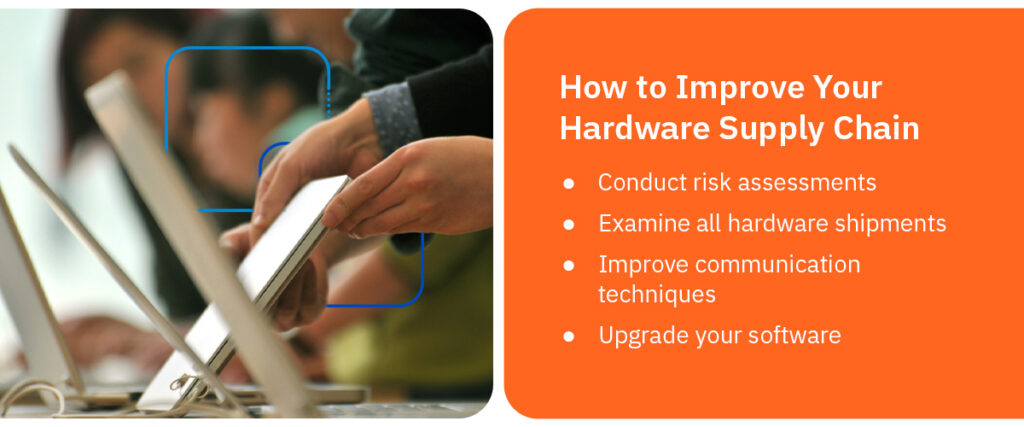
How to Improve Your Hardware Supply Chain
Supply chain managers can use various improvement strategies to improve their hardware product supply chain. These are a few ways to address hardware supply chain challenges:
- Conduct risk assessments: Risk analyses help determine the most pressing risks facing your supply chain. Depending on your location, supplier relationships, and product types, many different risks could impact your success. Map out your entire supply chain network and product flows, including suppliers, manufacturers, distributors, transport routes, and other essential stops. Then examine the end-to-end view of the supply chain, determine areas of risk, and build response plans. Some partnerships or internal operations can make you more vulnerable or restrict efficiency.
- Examine all hardware shipments: One of the best ways to address cyber threats against hardware is to enhance your inspection processes. Develop an examination procedure for hardware shipments. You can test security, review the supplier’s cybersecurity strategies, and ensure the hardware is free from obvious flaws. You can also request documentation from the supplier that vouches for its security and technical controls. If the hardware fails any portion of the inspection, don’t move forward with the device until you can investigate its security further.
- Improve communication techniques: You can’t eliminate supply chain disruptions, but you can improve your communication with suppliers. The better you communicate, the more you can reduce the negative impacts of delays. Straightforward and quick updates about delays or other issues keep other suppliers aware. They can adjust plans to make up for the problems, reducing downtime. Many software solutions, such as Electronic Data Interchange (EDI), can improve communication. This solution facilitates electronic document exchanges, reducing manual workloads.
- Upgrade your software: Technology updates let you prepare more effectively for risks and disruptions. If you haven’t upgraded your software in a while, evaluate its effectiveness. Advanced solutions reduce manual tasks, streamline communication, improve visibility, and offer many other benefits.
Maximize Your Hardware Supply Chain with TrueCommerce
By remaining resilient and agile, you can boost hardware supply chain optimization. A transformative solution such as EDI helps you face challenges with more preparation. Instantly view important documents from all supply chain stages and gain insights into product inventories and orders.
To learn more about our leading EDI solution, contact TrueCommerce today.

Improving Your Supply Chain in the Electronics Industry
The electronics industry is defined by innovation. A constant push for newer and more advanced technologies pressures manufacturers to increase production rates. The global consumer electronics market is projected to reach over $660 billion in 2023 and increase in worth each year. To remain competitive, you must supply rapid and high-quality solutions. Electronics companies feel these strains as they meet production deadlines and order requests.
As electronics grow more advanced, supply chains face more modern challenges. Managers can refine their approaches to stay agile and prepared for threats. Discover more about electronics supply chain issues and how to reduce their impacts on your organization.
Electronics Supply Chain Risks
Supply chain risks impede efficiency and reduce customer satisfaction. Common threats facing the electronics supply chain include:
- Material shortages: Electronic products need many raw materials for manufacturing. For instance, copper, nickel, gold, lithium, and fiberglass are commonly found in electronics. A raw materials shortage can make it difficult to meet production deadlines. These shortages could persist for extended periods, preventing sufficient production. If consumer demands increase, companies could be unable to meet their requests.
- Increased prices: Prices often rise during shortages, making it even harder to acquire necessary materials. In addition, raised costs in other supply chain areas limit efficiency. Businesses must cover expenses for production, energy, maintenance, materials, employee wages, transportation, and other essential costs. If these expenses increase, organizations must stretch available funds and work with limited resources, which can lower product quality and customer satisfaction levels.
- Lengthy shipping times: Many electronic components are manufactured overseas. For instance, China is famous for its electronics production, generating a projected revenue of over $220 billion in 2023. If supply chains have extended distances between their hubs and suppliers, they will likely face long shipping times. Even if you order a product while it’s in stock, you may not receive it for weeks or months.
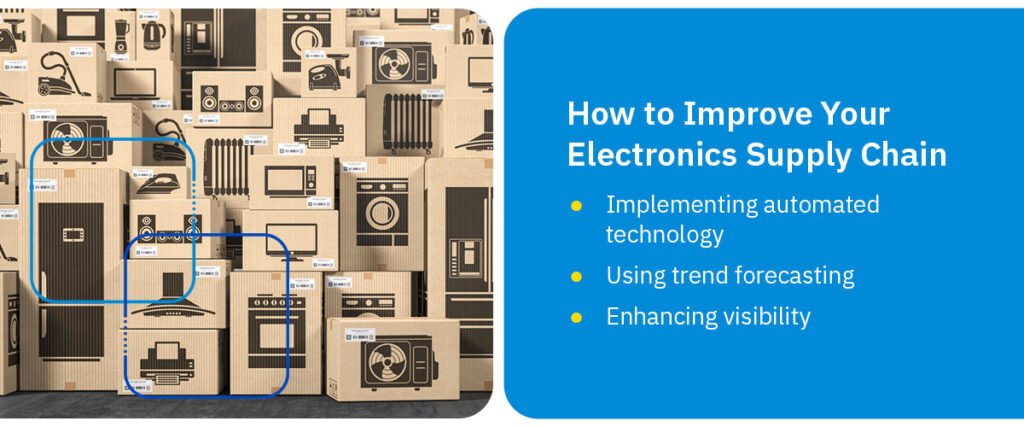
How to Improve Your Electronics Supply Chain
Despite these obstacles, you can use many improvement strategies to prepare your supply chain. Try techniques such as:
- Implementing automated technology: Automation assists with many supply chain operations. These advanced technology solutions complete manual tasks without human intervention, increasing efficiency across your supply chain. Automated tools can help with the challenges of acquiring electronic materials. Some systems automatically order more inventory when stock gets low, eliminating the need for manual orders. Other solutions create automated alerts so you can gain real-time insights into customer buying trends. Alerts can also inform you when a material is available for purchase again.
- Using trend forecasting: Forecasting also helps electronics organizations anticipate buying behaviors and material availability. The technology uses past order history, current inventory levels, and other critical data to predict inventory replenishment needs. For instance, a forecasting tool could indicate an upcoming raw material shortage. An electronics company could increase its order volume to ensure they have enough for production. By predicting inventory demands, you build more resilience and can respond to supply chain disruptions more effectively.
- Enhancing visibility: Comprehensive supply chain views let you track products through every stage and help you mitigate the impacts of material shortages and delays. Real-time data identifies product positions, inventory levels, and supplier updates. You’ll know a product’s location at every supply chain point, minimizing confusion about delivery times and allowing you to adjust production plans to reflect updated material availability. Solutions such as Vendor Managed Inventory (VMI) increase visibility across every supply chain level.
Enhance Your Electronics Supply Chain with TrueCommerce
Electronics companies build essential tools used daily around the world. Focusing on electronics supply chain optimization helps you meet customer demands more closely. VMI solutions offer complete inventory visibility across all supply chain stages. With robust preparation, you can minimize the effects of material shortages and lengthy delivery times.
Contact TrueCommerce today to learn more about our VMI solutions.

Improving Your Supply Chain in the Furniture Industry
The furniture supply chain manages all raw materials and parts, from manufacturing to final consumer delivery. Furniture is a broad industry with many customization options, which creates a large inventory selection. Changing consumer demands and supply chain delays can make it difficult to maintain efficiency.
Learn more about common furniture supply chain issues and how to improve your approaches.
Furniture Supply Chain Risks
Various risks make it harder to meet consumer demands. The furniture industry increases in value annually, and experts predict steady growth in upcoming years. As customer preferences change, it’s crucial to have adequate inventory to maximize profits. Furniture trends also affect material availability. For instance, a sudden demand for a particular color can make getting fabric in that color harder.
These are other risk factors that affect the furniture supply chain:
- Congested ports: Many furniture parts are manufactured overseas, adding extra shipping and handling times. When many parts arrive at once, American ports can become overwhelmed and unable to manage the demand efficiently. Congestion prevents timely deliveries and can impede visibility for other businesses. In turn, it becomes harder for transport professionals to meet delivery deadlines, which can decrease customer satisfaction.
- Inflation: Rising costs make it harder for furniture companies to manage resources. As consumers manage increased prices for food, rent, gas, and other necessities, they are less likely to be able to afford additional or new furniture. Because of these stresses, furniture companies may experience less demand and have less revenue. Additionally, inflation increases prices for materials, labor, transportation, energy, and other supply chain expenses. Decreased consumer spending and rising supply chain costs increase pressure on furniture companies.
- Rising eCommerce demands: Many customers now prefer to order furniture online instead of browsing stores in person. Online shopping affords customers ultimate convenience and search options, eliminating the stress of in-store crowds and limited inventory. However, the rise of eCommerce pressures the supply chain with increased order demands. Furniture companies must use proper inventory management techniques to reflect available inventory accurately and avoid stock-outs. Lack of visibility can make it challenging to track eCommerce orders through the supply chain.
- Changing customer demands: Furniture has many customization options. You can choose specific colors, sizes, configurations, and brands. Manufacturers typically take longer to build custom designs, increasing order processing times. Abrupt changes in style can also limit material availability, making it more difficult to produce furniture.

How to Improve Your Furniture Supply Chain
While these supply chain risks make it more difficult to meet production goals, you can build response plans to keep your supply chain agile and resilient. Potential strategies include the following:
- Focus on customer service: Customer satisfaction is crucial for brand loyalty. Inflation, congestion, and abrupt demand changes are external risks, but strong customer service techniques can mitigate their effects. Providing personal and helpful assistance or offering discounts, replacements, and refunds can reduce some of the disappointment from order delays or other customer complaints. Focus on providing consistent and quick customer service responses. Many technological tools can help you connect with customers quickly. For instance, online chatbots can respond to common customer questions or reroute them for more assistance.
- Increase product offerings: Offering a more diverse product range can help your supply chain address issues with congestion. If most of your materials are international shipments, you experience additional shipping times and the possibility of overloaded ports. You could increase brand and product types by partnering with local suppliers. The closer your supplier is, the more quickly you receive materials. Additionally, closer proximity can limit the effects of adverse weather.
- Upgrade your software: Supply chain technology helps you manage potential furniture delays. Vendor Managed Inventory (VMI) and Electronic Data Interchange (EDI) are two options that build resilience and efficiency. VMI uses point-of-sale and demand forecasting to optimize inventory management. You can improve collaboration with suppliers with real-time data updates and enhanced accuracy. EDI instantly exchanges business documents with suppliers, eliminating manual data entry and the potential for human error. Investing in new software solutions helps you optimize operations while reducing manual workloads.
Solve Furniture Supply Chain Challenges with TrueCommerce
Furniture supply chain optimization is easier with robust software tools. TrueCommerce is a leading provider of supply chain VMI and EDI solutions. Contact us today to learn more about how we can help your supply chain.
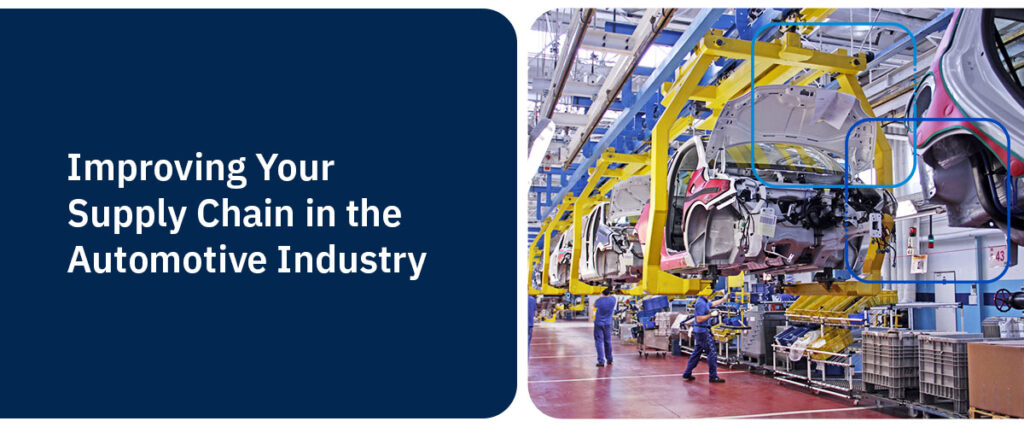
Improving Your Supply Chain in the Automotive Industry
The automotive industry manages the design, production, sale, and distribution of automotive vehicles. Cars require many parts to function properly, from windshield wipers to steering wheels. The automotive supply chain monitors the flow of parts and ensures manufacturing and distribution proceed according to plan.
Strengthening your supply chain techniques minimizes risks. The more prepared you are, the better equipped your automotive company is to handle challenges in the supply chain. Learn about frequent automotive supply chain risks and some of the best strategies for overcoming them.
Automotive Supply Chain Risks
The automotive supply chain is notoriously complex, managing thousands of different parts for various vehicles. From raw materials to finalized models, many organizations must work together to create high-quality products. The many moving parts create more opportunities for vulnerabilities.
Here are some common automotive supply chain issues:
- Lack of visibility: Visibility is vital for the automotive supply chain. Every vehicle needs thousands of parts to function, making traceability essential. The absence of a few parts could delay production for weeks. In addition, a lack of visibility negatively impacts inventory management. Your ordering strategies could be inaccurate without a clear view of incoming products. You could over- or under-stock particular parts. Extra stock takes up more warehouse space, increasing monthly costs. If you don’t have enough supplies, you could be unable to meet customer needs or proceed with vehicle manufacturing.
- Lack of quality control: Car manufacturers need high-quality, sturdy parts to build vehicles. Manufacturers must also use proper assembly methods. After they complete assembly, thorough inspections are necessary to ensure safety. A lack of quality control can result in faulty or unsafe cars. Quality issues can damage a company’s reputation, resulting in recalls, revenue loss, and waste.
- Lack of sustainability: Sustainability is a growing concern for most modern industries. Automotive manufacturers now face more pressure to adopt environmentally friendly practices. Vehicle assembly uses a significant amount of energy, plastic, and other materials. Once they’re on the road, cars release emissions into the air that leave a massive carbon footprint. Manufacturers must adjust approaches to reduce their carbon footprints and remain competitive.

How to Improve Your Automotive Supply Chain
These methods can help you address automotive supply chain challenges and build agility:
- Focus on meeting customer needs: A resilient technique is to focus on meeting customer needs. The top brands and parts can cost much more and take longer to ship than other components. If you can fulfill needs and provide strong customer service with local or less expensive parts, your supply chain remains efficient.
- Improve your monitoring techniques: Adaptability is crucial for supply chains, letting them pivot from current techniques to more effective ones. Advanced monitoring systems can identify risks and delays in real time. Various software tools help you monitor automotive parts through every supply chain stage. You can use real-time data updates to track parts and update manufacturing techniques. Tracking also assists with inventory management techniques.
- Establish an automotive supply chain optimization team: By designating an optimization team, you can dedicate sufficient resources to supply chain approaches. These team members can constantly track supply chain trends and inventory levels to make informed decisions. Your optimization team could consist of current staff members, or you could hire new ones just for this purpose.
Overcome Automotive Supply Issues with TrueCommerce Solutions
Advanced software solutions help your automotive supply chain stay as efficient as possible. Options such as Vendor Managed Inventory (VMI) and Electronic Data Interchange (EDI) enhance visibility, efficiency, communication, traceability, and other essential supply chain factors.
VMI focuses on inventory management, boosting product visibility and forecasting buying behaviors. EDI streamlines collaboration with supply chain partners by instantly exchanging business documents. You can use these solutions to improve efficiency across your automotive supply chain.
TrueCommerce is a leading provider of EDI and VMI supply chain solutions. To learn more about our offerings, contact us today.
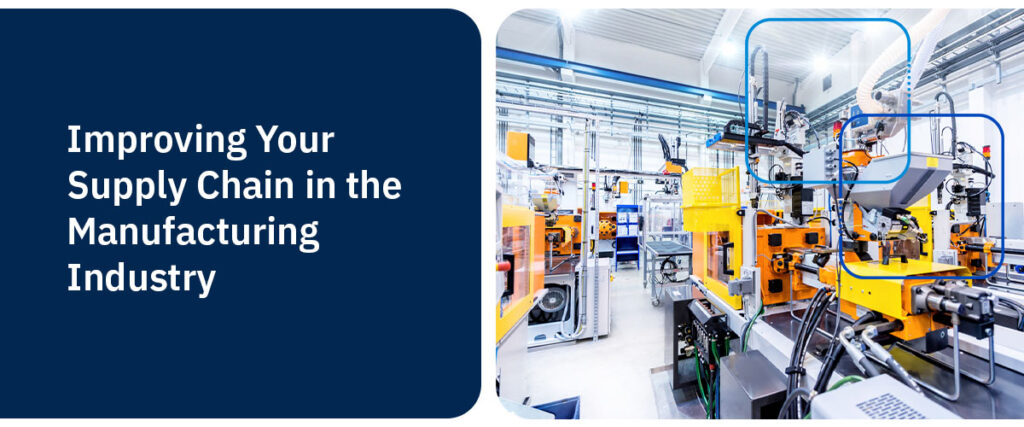
Improving Your Supply Chain in the Manufacturing Industry
The manufacturing industry works with various retailers, business users, consumers, and other third parties. They face pressure from these sources to deliver timely and high-quality products. As market demands change, it can become challenging to balance efficiency with quality.
Anticipating and addressing manufacturing risks helps your supply chain remain as efficient as possible. Read about these manufacturing supply chain risks and learn the best ways to build resilient response plans.
Manufacturing Supply Chain Risks
The manufacturing supply chain processes products for many industry types. The constant demand and wide variety of clients can cause vulnerabilities from sources such as:
- Cyberattacks: As manufacturing businesses adopt new technologies, they expose themselves to new cyber threats. Malicious attackers often target manufacturers to gain sensitive data, such as financial information. The average cost of a data breach in 2022 was more than $9 million, causing severe financial losses. Breaches can also destroy supplier partnerships and company reputations. Organizations need robust cybersecurity strategies to protect employee, partner, and customer data.
- Supply chain delays: Similar to other supply chain types, delays significantly affect the manufacturing supply chain. Producers need regular supplies of raw materials to build products. If they can’t access these resources according to schedule, entire timelines become disrupted. Other companies rely on manufacturers to process order requests. When manufacturers face disruptions, other organizations feel the consequences. Anticipating disruptions and taking proactive measures can help manufacturers avoid the worst effects.
- Raw material price increases: Manufacturing businesses work directly with raw material suppliers for production. If material prices increase, it becomes more difficult for manufacturers to obtain the necessary supplies. Manufacturers must also manage overhead costs, employee wages, and other essential expenses. Increased prices prevent supply chains from running efficiently.
- Competing manufacturers: With so many manufacturers in the market, organizations can struggle to remain competitive. If major brands merge, they can create monopolies that make it much harder for smaller companies to thrive. Manufacturers must also stay updated with buying trends and technological advances to remain competitive.
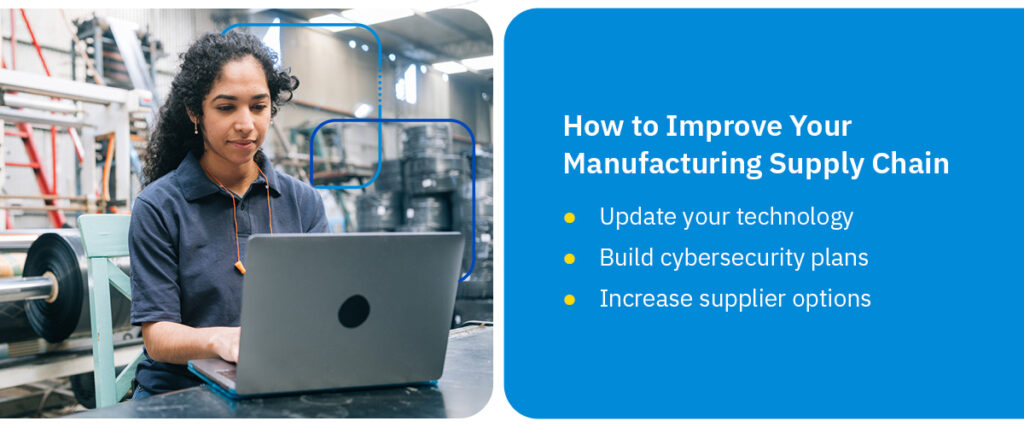
How to Improve Your Manufacturing Supply Chain
Despite manufacturing supply chain issues, you can empower your supply chain to stay agile and strong. Here are a few strategies for improving your manufacturing supply chain:
- Update your technology: Many manufacturers use disparate or outdated systems to complete regular operations. While these systems are helpful and comfortable, they can add unnecessary process time. For instance, manual data transfers between systems are tedious and prone to human error. By investing in upgraded and integrated technology, you can sync applications. Software solutions can also improve product visibility and supplier communications, building a more efficient supply chain.
- Build cybersecurity plans: Cybersecurity plans are vital as malicious attackers create more advanced cyberattacks. You can identify common attack types and develop response plans to stay proactive. For example, if you notice phishing attacks are frequent in your organization, you could build stronger filtering systems to identify unknown messages and prevent them from reaching employee inboxes. Comprehensive training techniques and security software also help keep your company secure.
- Increase supplier options: Diversifying your supplier connections helps you respond to delays more effectively. If you only have international suppliers, travel restrictions or weather conditions could prevent on-time deliveries. You could also partner with local sources as backup options. The closer your supplier is, the more quickly they can deliver supplies. One source can face significant disruptions while another stays on schedule. If you have more options, you can avoid severe delays and stay as close to production goals as possible.
Optimize Your Manufacturing Supply Chain with TrueCommerce
One of the best ways to remain competitive in the manufacturing industry is to upgrade your technology. Your software affects visibility, communication, and security. Solutions such as Electronic Data Interchange (EDI) and Vendor Managed Inventory (VMI) boost visibility across your supply chain. Other integrated solutions let you link your existing systems, streamlining manual processes.
TrueCommerce offers a wide range of technological solutions for supply chains. To learn more about how we can assist with manufacturing supply chain optimization, contact us today.
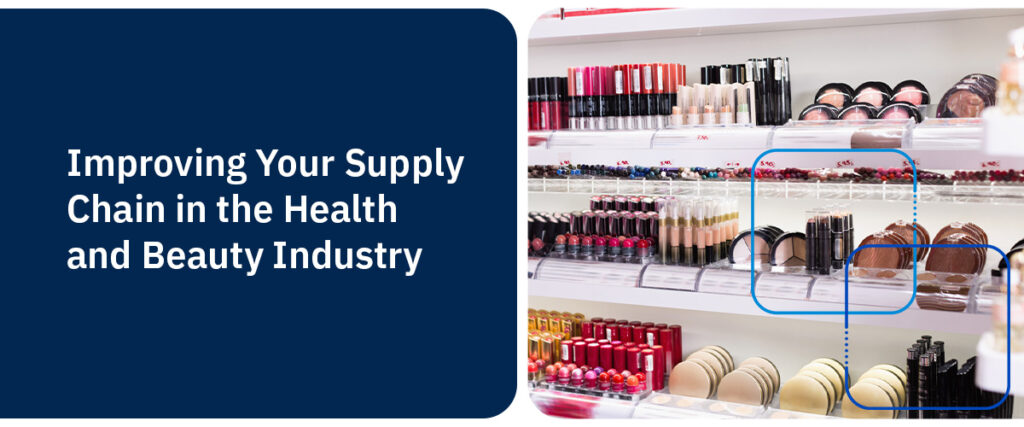
Improving Your Supply Chain in the Health and Beauty Industry
The health and beauty industry manages countless products and consumer demands. Customers have a broad range of products to choose from, making it difficult to remain competitive in the field. Sustainability desires and abrupt trends also place strain on supply chains. With proactive preparation and advanced software, health and beauty organizations can build resilience.
Explore common beauty supply chain issues and the best ways to strengthen your operations.
Health and Beauty Supply Chain Risks
It’s important to stay aware of supply chain risks so you can prepare effectively. Various challenges make it difficult for health and beauty organizations to work efficiently. These are a few examples:
- Abundant options: The health and beauty industry is famous for its many choices. Beauty products range widely by skin type, condition, scent, appearance, volume, and other specifications. Consumers expect products tailored to their exact needs and look for brands that can supply the best-quality items. To keep up with competing companies, organizations can expand their product offerings, which can strain available resources. Increasing product numbers also complicates inventory management. Each unit has its own stock keeping unit (SKU), storage requirements, and shipping needs.
- Supply and demand changes: The health and beauty market experiences many trends. Abrupt changes in demand strain supply chains and make it difficult to maintain adequate stock. For instance, a celebrity could endorse your brand and product, then wear the product to a publicized event. Fans of the celebrity could express new interest in your product, causing a surge in orders. If you didn’t anticipate the demand, you could face stock-outs and unsatisfied customers.
- Popularity increase for eCommerce: Similar to other industries, the health and beauty industry is experiencing rapid growth in eCommerce. More than one-third of Gen Z shoppers purchase beauty products online. To meet this preference and remain competitive, health and beauty suppliers must create a seamless online shopping experience. Companies could be unprepared to establish or refine an online presence, straining available resources. Online orders can also complicate shipping processes.
- Demand for sustainable products: Many consumers want sustainable beauty products, especially as climate change concerns grow. Makeup and health products often arrive in plastic or unsustainable materials, increasing the industry’s carbon footprint. Shoppers of all generations express increased interest in sustainable products and are willing to pay more for responsibly sourced packaging. To meet these demands, companies must redesign packaging and shipping methods, but many businesses don’t have the time or resources for these changes.

How to Improve Your Health and Beauty Supply Chain
Your organization can adopt new methods and commit to new approaches to address beauty supply chain issues. These are a few ways to improve your supply chain:
- Adopt greener methods: As consumers call for more sustainable practices in production and distribution, companies can adopt greener practices to stay competitive. Waste reduction is a significant way to increase sustainability. For instance, you could switch to digital methods instead of managing physical documents. You could also redesign packaging to feature recyclable materials and smaller dimensions. Remain transparent with consumers about production methods and emphasize green practices within your facilities.
- Enhance your online presence: The growth of eCommerce requires health and beauty companies to increase their online presence. Many consumers research products on the internet, making it essential for your business to have product descriptions and brand explanations available online. A seamless, high-quality website can convince customers to finalize purchases with you instead of a competitor. In addition, social media pages let you connect with customers more closely and provide more opportunities to increase brand awareness.
- Invest in new technology: Managing countless SKUs and product specifications can quickly become difficult. Many software solutions help you organize product information and give key insights into inventory data. For example, syncing your eCommerce platform with an inventory management solution streamlines the order processing timeline. Vendor Managed Inventory (VMI) solutions forecast buying trends, preparing you for sudden changes in demand. These solutions increase efficiency across your supply chain, helping you quickly meet consumer needs.
Manage Health and Beauty Supply Chain Issues with TrueCommerce
Whether you sell a few beauty products or manage a massive inventory, beauty supply chain optimization can seem challenging. The right software integrations and solutions can transform your management approaches and help set you apart.
TrueCommerce supplies a wide range of supply chain solutions that can enhance your beauty and health organization. To learn more, contact us today.
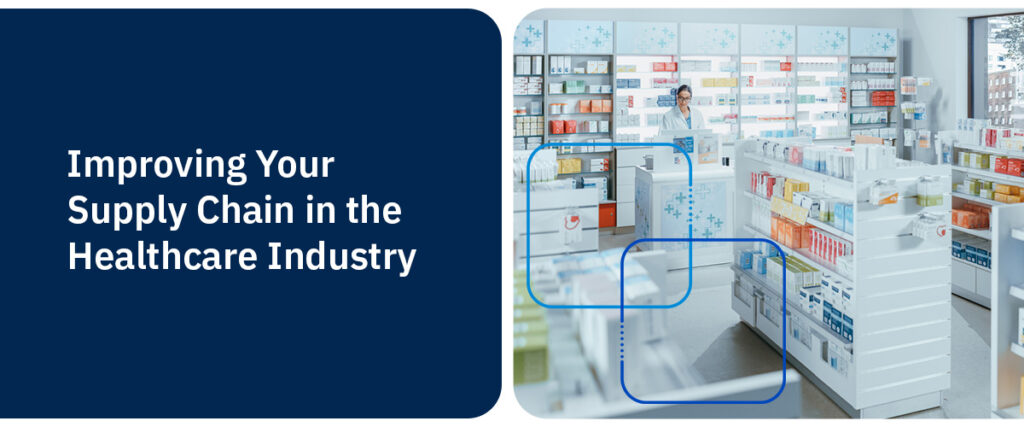
Improving Your Supply Chain in the Healthcare Industry
The healthcare supply chain manages essential products for the public’s health. Whether organizations distribute supplies to pharmacies, healthcare institutions, or directly to consumers, healthcare supply chains play a vital role in public well-being.
However, growing demands, competing brands, and other supply chain risks make it challenging to meet needs. Learn more about healthcare supply chain issues and the best ways to address them.
Healthcare Supply Chain Risks
Many supply chain risks prevent healthcare organizations from operating at their best. These are frequent examples:
- Rapid deliveries: Many healthcare companies and institutions need fast or overnight deliveries to manage customer needs. Emergency procedures could require out-of-stock products, placing significant strain on supply chains to deliver them in time. You could need additional employees or resources to manage these order requests. If many orders occur at once and you can’t meet the demands, it could damage client relationships.
- Cyberattacks: The healthcare industry was the most targeted industry for cyberattacks in 2022. Malicious attackers seek sensitive patient data, financial details, and other private information. Attackers also target healthcare supply chains for these reasons. If they successfully breach your systems, everyone in your supply chain could face severe financial and personal consequences.
- Cost management: Healthcare supply chains must also manage rising costs for materials and shipping. Institutions rely on steady supplies to keep operations running smoothly. For instance, personal protective equipment (PPE) is necessary for employees, and patients require specific medications. As prices fluctuate, it becomes harder for supply chains to acquire these materials and operate efficiently.
- Outdated systems: Most healthcare supply chains use software solutions to process orders, communicate with partners, and complete other vital tasks.However, legacy systems and software limit adaptability and agility. If you use several disconnected systems, they may not always reflect accurate data. Outdated applications may also have slow loading times and could experience significant downtime, impeding operations.

How to Improve Your Healthcare Supply Chain
Healthcare supply chains can use innovative and comprehensive strategies to respond to these risks. Proactive techniques let you mitigate the impacts of threats before they grow more severe. For example, you could adopt methods such as the following:
- Investing in automation: Automated solutions streamline manual processes, boosting efficiency in your supply chain with minimal manual effort. Many outdated systems require manual data transfers and communication methods. By upgrading to software with automation, you can manage orders and supplier communications more effectively. For instance, Electronic Data Interchange (EDI) instantly exchanges key documents between you and suppliers. You can view real-time, accurate data instead of using time-consuming processes and manage more orders without additional staff or strain.
- Evaluating most pressing risks: Regular risk assessments let you identify the most pressing concerns at one point in time. You can map an end-to-end view of all supply chain operations, including suppliers, distribution paths, and end users. Then, analyze these pathways to find bottlenecks or areas that need improvement. If you notice recurring problems, build response plans to prevent them from happening again. For example, if you notice cybersecurity is the most significant issue for your organization, you could invest in new security technologies to shield your sensitive data.
- Improving visibility: Transparency lets you track materials and products through every supply chain stage. Many technology solutions, such as Vendor Managed Inventory (VMI), assist with traceability. Real-time insights into inventory levels help you prevent stock-outs and remain prepared for unexpected orders.
Strengthen Your Healthcare Supply Chain with TrueCommerce
Quick and accurate systems help your healthcare organization operate at optimal efficiency. TrueCommerce offers many supply chain solutions that enhance visibility and increase productivity. To learn more about how we can help your healthcare supply chain optimization process, contact us today.
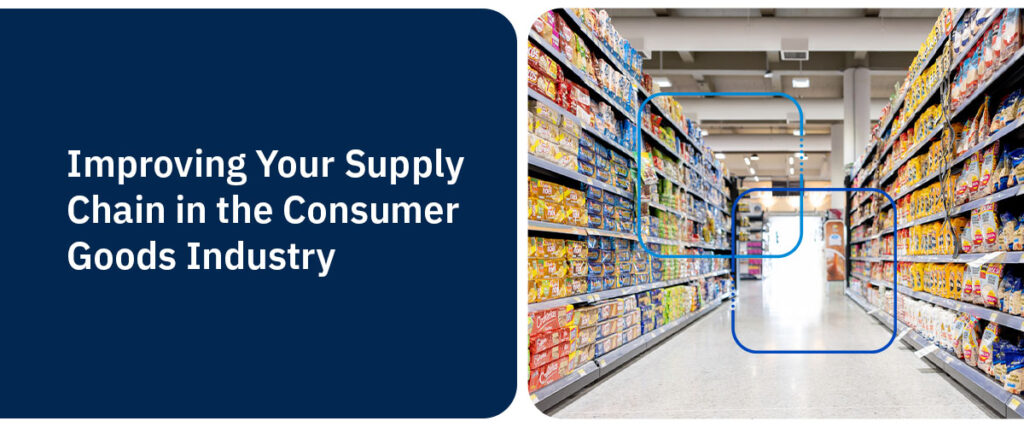
Improving Your Supply Chain in the Consumer Goods Industry
The Consumer Packaged Goods (CPG) industry facilitates a wide range of consumer products. This competitive market features countless brands and experiences many demand changes. The consumer goods supply chain tracks these products from initial development to final delivery, playing an essential role in customer satisfaction.
Read about various risks associated with the CPG industry and how severely they impact operations. Then, explore strategies for overcoming these obstacles.
Fast-Moving Consumer Goods Supply Chain Risks
Various internal and external threats prevent CPG supply chains from operating effectively. Frequent consumer goods supply chain issues include the following:
- Shift to eCommerce: The abrupt surge in eCommerce preferences places more pressure on the CPG industry. Organizations must alter packaging and distribution techniques to manage more orders. Each order has specific storage and time considerations, straining available resources and facilities. In addition, eCommerce growth creates more demand for high-quality websites and product descriptions.
- Increasing labor costs: Rising labor prices make it harder for CPG businesses to manage available resources. The more it costs companies to hire employees, the less funds they have for other overhead costs. Organizations employing fewer workers may have lower productivity rates and struggle to meet order deadlines.
- Lacking visibility: It’s often difficult to gain comprehensive views of product movements in the rapidly expanding CPG industry. With so many sources and competing brands, visibility becomes harder to manage. Supply chains can lose track of products or not have access to complete data insights, making it more difficult to forecast delivery times.
How to Improve Your Fast-Moving Consumer Goods Supply Chain
You can take proactive and measured steps to respond to these risks. Integrate methods such as the following:
- Focus on inventory management: The CPG industry is defined by fast-moving products of all kinds. No matter the type of item you manage, robust inventory management techniques are necessary for success. Technology upgrades can boost visibility and streamline inventory processes, helping you track inventory more easily. For instance, Vendor Managed Inventory (VMI) solutions provide real-time inventory data and insights. It uses the data to predict replenishment needs, limiting stock-outs or over-ordering.
- Strengthen supplier relationships: Supply chains need strong collaborative relationships to process orders effectively. Whether you ship products directly to consumers or to other businesses, transparent communication helps them move more smoothly. You can streamline communication with various technology solutions. For instance, software can give partners real-time insights into product movements without additional effort, and quick communication methods like online chatting let you connect with customers instantly.
- Invest in automation technology: Automation technology assists with the challenges of rising labor costs. By automating manual procedures, you cut back on manual workloads. For example, automated solutions can automatically transfer data between systems or to suppliers. Instead of employees manually typing each update, the technology immediately updates the system with perfect accuracy. You can boost efficiency and reduce the need for additional employees, keeping costs lower.
Overcome Consumer Goods Supply Chain Challenges with TrueCommerce
Consumer goods supply chain optimization is vital for staying competitive. Whether you have an improvement plan in mind or don’t know where to start, we’re here to help. TrueCommerce offers a wide range of supply chain solutions to optimize your operations. Contact us today to get started.
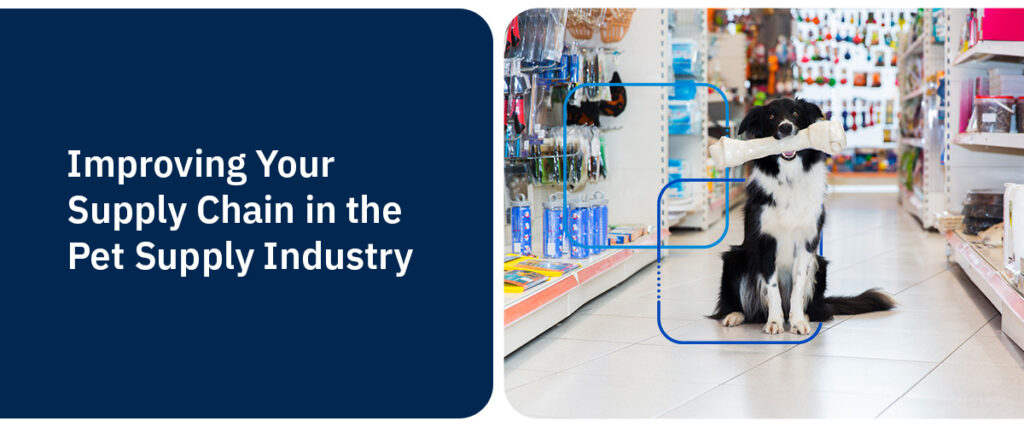
Improving Your Supply Chain in the Pet Supply Industry
The pet supply industry manages pet products for consumers worldwide. It experiences consistent growth each year, with consumers spending over $136 billion in 2022 in the United States.
As the market continues to expand, pet supply companies must alter their strategies to remain competitive. Various threats make it harder to meet production deadlines and consumer expectations. Learn more about pet supply chain issues and targeted strategies to resolve them.
Pet Products Supply Chain Risks
These are a few of the most pressing issues for the pet products supply chain:
- Rising packaging costs: Pet supplies include many products, from food to toys. Each item has unique packaging requirements to keep it safe during transport and until delivery. Global inflation has driven up costs for packaging, complicating the process for pet supply companies. To compromise, organizations can use less durable materials. However, these may not protect items sufficiently during shipments and result in unhappy customers.
- Food safety procedures: Pet food companies must follow proper packaging and sourcing practices to ensure pets stay safe. You must comply with these protocols throughout every supply chain stage. For instance, suppose a certain type of dog food needs refrigeration. If a product is unaccounted for and not refrigerated, it could be unsafe for dogs after delivery. Failure to follow safety procedures can also result in product recalls, which cause financial losses and customers to seek alternative brands.
- Difficulties obtaining materials: Various material shortages make it difficult to produce pet products. Global and local delays restrict delivery times and production deadlines. If you partner with overseas suppliers, these delays can be significantly longer and more expensive.
How to Improve Your Pet Products Supply Chain
Fortunately, you can avoid the adverse effects of these risks by building resilience and robust response strategies, including the following:
- Thoroughly investigate suppliers: To keep pet food and product at top quality, partner with safe and experienced suppliers. Before connecting with new partners, research their production or packaging methods. Building a network of reliable and trustworthy suppliers boosts your reputation and helps you provide the best possible items for pet owners.
- Increase connections: If you have difficulties acquiring materials, consider increasing your number of suppliers. International suppliers or those at a significant distance can cause shipping delays. You can partner with local suppliers to have a backup source for materials in case disruptions occur. That way, you remain on schedule for delivery and production times without waiting for the delays to pass.
- Enhance traceability efforts: Traceability and inventory management are vital for safely handling pet food products. You can invest in new solutions that provide instant updates on product whereabouts. Software options create audit trails as food passes through the supply chain, proving the product’s location and storage conditions. In addition, real-time data provides insights into customer buying patterns and helps you anticipate upcoming trends. Then, you can adjust your inventory ordering techniques to match forecasted demand.
Choose TrueCommerce to Improve Your Pet Products Supply Chain
With the right strategies, you can transform your supply chain to meet your needs and operate efficiently. TrueCommerce specialists can help you develop a pet supply chain optimization plan for your circumstances and industry needs. Contact us today to get started with a specialist.

Build a Better Supply Chain with TrueCommerce
From the electronics industry to the pet supply industry, each supply chain has threats that make it challenging to run optimally. The rapid expansion of eCommerce adds strain to packaging approaches and delivery demands, while material shortages limit production capabilities and lengthen distribution times. Increasing costs impact all supply chain areas and make it even more challenging to allocate resources.
Supply chains can apply many strategies to reduce the impacts of these risks. One of the best ways to prepare your supply chain is with robust technology solutions. Advanced software assists with trend forecasting, order replenishment, product visibility, supplier communications, and other essential aspects of operations.
Solutions such as Vendor Managed Inventory (VMI) make it easy to share inventory data across the supply chain. With detailed data, you can ensure availability accuracy for customers and suppliers. You can also enhance ordering techniques based on previous buying patterns. Electronic Data Interchange (EDI) improves supplier relations with instant document transfers and seamless integrations.
TrueCommerce offers many supply chain solutions that improve efficiency and resiliency. We can help you create the ideal response plans and solutions to optimize your supply chain. To speak with a specialist, contact us today.